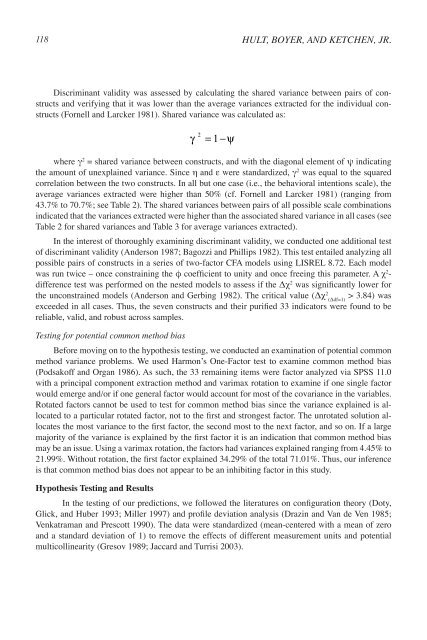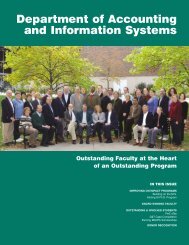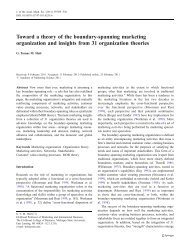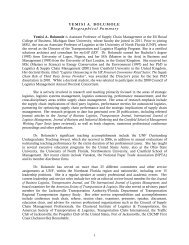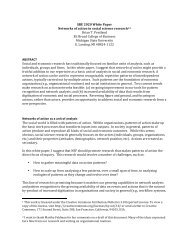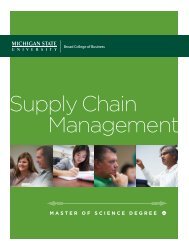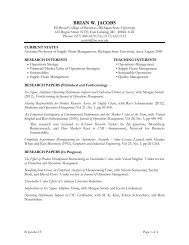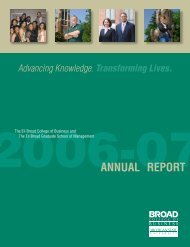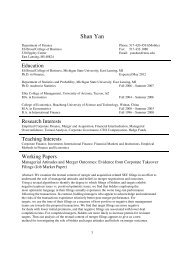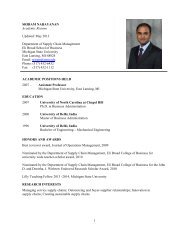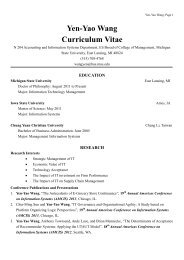118 hult, boyer, and ketchen, Jr.Discriminant validity was assessed by calculating the shared variance between pairs <strong>of</strong> constructsand verifying that it was lower than the average variances extracted for the individual constructs(Fornell and Larcker 1981). Shared variance was calculated as:2γ = 1 −ψwhere γ 2 = shared variance between constructs, and with the diagonal element <strong>of</strong> ψ indicatingthe amount <strong>of</strong> unexplained variance. Since η and ε were standardized, γ 2 was equal to the squaredcorrelation between the two constructs. In all but one case (i.e., the behavioral intentions scale), theaverage variances extracted were higher than 50% (cf. Fornell and Larcker 1981) (ranging from43.7% to 70.7%; see Table 2). The shared variances between pairs <strong>of</strong> all possible scale combinationsindicated that the variances extracted were higher than the associated shared variance in all cases (seeTable 2 for shared variances and Table 3 for average variances extracted).In the interest <strong>of</strong> thoroughly examining discriminant validity, we conducted one additional test<strong>of</strong> discriminant validity (Anderson 1987; Bagozzi and Phillips 1982). This test entailed analyzing allpossible pairs <strong>of</strong> constructs in a series <strong>of</strong> two-factor CFA models using LISREL 8.72. Each modelwas run twice – once constraining the φ coefficient to unity and once freeing this parameter. A χ 2 -difference test was performed on the nested models to assess if the Δχ 2 was significantly lower forthe unconstrained models (Anderson and Gerbing 1982). The critical value (Δχ 2 > 3.84) was(Δdf=1)exceeded in all cases. Thus, the seven constructs and their purified 33 indicators were found to bereliable, valid, and robust across samples.Testing for potential common method biasBefore moving on to the hypothesis testing, we conducted an examination <strong>of</strong> potential commonmethod variance problems. We used Harmon’s One-Factor test to examine common method bias(Podsak<strong>of</strong>f and Organ 1986). As such, the 33 remaining items were factor analyzed via SPSS 11.0with a principal component extraction method and varimax rotation to examine if one single factorwould emerge and/or if one general factor would account for most <strong>of</strong> the covariance in the variables.Rotated factors can<strong>no</strong>t be used to test for common method bias since the variance explained is allocatedto a particular rotated factor, <strong>no</strong>t to the first and strongest factor. The unrotated solution allocatesthe most variance to the first factor, the second most to the next factor, and so on. If a largemajority <strong>of</strong> the variance is explained by the first factor it is an indication that common method biasmay be an issue. Using a varimax rotation, the factors had variances explained ranging from 4.45% to21.99%. Without rotation, the first factor explained 34.29% <strong>of</strong> the total 71.01%. Thus, our inferenceis that common method bias does <strong>no</strong>t appear to be an inhibiting factor in this study.Hypothesis Testing and ResultsIn the testing <strong>of</strong> our predictions, we followed the literatures on configuration theory (Doty,Glick, and Huber 1993; Miller 1997) and pr<strong>of</strong>ile deviation analysis (Drazin and Van de Ven 1985;Venkatraman and Prescott 1990). The data were standardized (mean-centered with a mean <strong>of</strong> zeroand a standard deviation <strong>of</strong> 1) to remove the effects <strong>of</strong> different measurement units and potentialmulticollinearity (Gresov 1989; Jaccard and Turrisi 2003).
<strong>Journal</strong> <strong>of</strong> <strong>Business</strong> Logistics, <strong>Vol</strong>. <strong>28</strong>, No. 2, <strong>2007</strong> 119The first step in the pr<strong>of</strong>ile deviation analysis was to identify ideal quality-based pr<strong>of</strong>iles thatcould be used as the benchmark against which the fit <strong>of</strong> all pr<strong>of</strong>iles in the sample with operational<strong>logistics</strong> strategy type could be examined (Doty, Glick, and Huber 1993; Vorhies and Morgan 2003).To identify the ideal pr<strong>of</strong>iles in each strategy type, we examined the frequencies <strong>of</strong> the outcomevariable (customers’ behavioral intentions) coupled with the general guidelines in pr<strong>of</strong>ile deviationstudies <strong>of</strong> selecting about 10% <strong>of</strong> the customers to be included in the ideal pr<strong>of</strong>ile (Venkatraman andPrescott 1990). For each operational <strong>logistics</strong> strategy, we selected a cut-<strong>of</strong>f point within the top 10%<strong>of</strong> the customers where a significant drop-<strong>of</strong>f in repurchase intentions was apparent (this resulted ina range <strong>of</strong> 16 to 70 cases being included in each ideal pr<strong>of</strong>ile). One concern was that our tests couldbe self-fulfilling prophecies because one dataset provided both the ideal pr<strong>of</strong>iles and the rest <strong>of</strong> thedata. To be clear, each <strong>of</strong> the four ideal pr<strong>of</strong>iles was developed based on the perceptions <strong>of</strong> a firm’sbest customers. Our hypotheses in essence examine the expectation that the closer the perceptions <strong>of</strong>a firm’s customers in general align with those held by the firm’s best customers, the stronger the repurchaseintentions <strong>of</strong> customers in general. These hypotheses did <strong>no</strong>t have to be supported becauseit is possible that each firm would attract a diverse array <strong>of</strong> customers (i.e., what the marketing fieldcalls different market segments).In testing the hypotheses, we calculated the mean scores <strong>of</strong> the top customers for each operational<strong>logistics</strong> strategy type on the three constructs <strong>of</strong> service-, product-, and e<strong>Business</strong> qualityto form an ideal quality pr<strong>of</strong>ile (Venkatraman 1989; Vorhies and Morgan 2003). For the remainingcustomers, we calculated the Euclidian distance <strong>of</strong> each case from the ideal quality pr<strong>of</strong>ile (EDQ)for its operational <strong>logistics</strong> strategy type across the three quality dimensions (Drazin and Van de Ven1985; Venkatraman 1990). The following formula was used:EDQ=N∑j( X sj− Xij2)where X sj= the score for a customer case on the jth dimension, X ij= the mean for the ideal pr<strong>of</strong>ilealong the j th dimension, and j = the number <strong>of</strong> pr<strong>of</strong>ile dimensions (i.e., 1, 2, and 3).These calculations result in a pr<strong>of</strong>ile deviation score that represents the degree to which thequality pr<strong>of</strong>ile is similar to that <strong>of</strong> the ideal pr<strong>of</strong>ile for each strategic type. The pr<strong>of</strong>ile deviation scorewas then regressed, using the OLS method, on repurchase intentions. We also included three controlvariables: attitude toward Internet ordering, online accessibility, and sacrifice (see the Appendix forthe scale items). For our hypotheses to be supported, the results should indicate that deviation fromthe ideal quality pr<strong>of</strong>ile is negatively related to the outcome variable for each <strong>of</strong> the operational <strong>logistics</strong>strategy types (Drazin and Van de Ven 1985; Gresov 1989).Prior to testing the hypotheses, it was important to validate two assumptions regarding our strategytype conceptualization (Vorhies and Morgan 2003). First, configuration theory (Doty, Glick, andHuber 1993) coupled with research on strategy types (Conant, Mokwa, and Varadarajan 1990; Slaterand Olson 2000) assumes that any one <strong>of</strong> the operational <strong>logistics</strong> strategy types can lead to superiorrepurchase intentions among customers. As such, we examined – via analysis <strong>of</strong> variance tests withunequal cell sizes (ANOVA) – that repurchase intentions variations between cases in our dataset were<strong>no</strong>t simply a function <strong>of</strong> strategy type. The ANOVA results revealed <strong>no</strong> significant differences be-
- Page 1 and 2: Journal of Business Logistics, Vol.
- Page 3 and 4: Journal of Business Logistics, Vol.
- Page 6 and 7: 110 hult, boyer, and ketchen, Jr.FI
- Page 8 and 9: 112 hult, boyer, and ketchen, Jr.at
- Page 10: 114 hult, boyer, and ketchen, Jr.No
- Page 13: Journal of Business Logistics, Vol.
- Page 17 and 18: Journal of Business Logistics, Vol.
- Page 19 and 20: Journal of Business Logistics, Vol.
- Page 21 and 22: Journal of Business Logistics, Vol.
- Page 23 and 24: Journal of Business Logistics, Vol.
- Page 25 and 26: Journal of Business Logistics, Vol.
- Page 27 and 28: Journal of Business Logistics, Vol.


